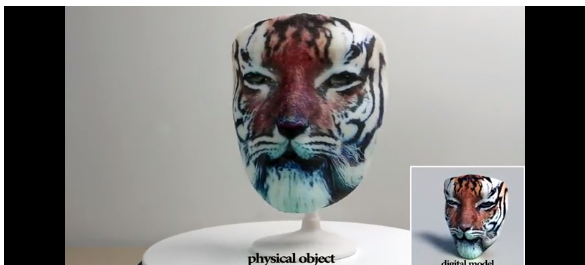I have to admit that it took me a moment to get past the GIF to the right, which shows what appears to be a cat in an advanced state of rigor mortis being submerged into a vat of liquid. Repeatedly. Once I realized that the story itself is not in any way about immersing dead pets, whether for profit or for pleasure, I was able to appreciate what a truly cool innovation was being demonstrated.
Researchers at Zheijiang University and Columbia University — including Yizhong Zhang, Chunji Yin, Changxi Zheng, and Kun Zhou — have been working to bring greater precision to a technique known as hydrographic printing. “Hydro” gives the hint about the liquid I  was seeing – hydrographic printing is the process of adding a printed design to a 3D surface by immersing the object into a liquid upon which is floating a gravure-printed polyvinyl alcohol (PVA) film that wraps around the object and adheres to it.
was seeing – hydrographic printing is the process of adding a printed design to a 3D surface by immersing the object into a liquid upon which is floating a gravure-printed polyvinyl alcohol (PVA) film that wraps around the object and adheres to it.
While the entertainment value of such a process is immediately apparent, its limitations are what caught the idea of the Zheijiang University researchers. While the application of the print is very stable and able to work with a nearly unlimited number of shapes and materials, it lacks a great deal of precision.
And if there is one thing about which 3D printers are obsessive, it is precision.
The lack of precision is a result of the stretching that occurs when an object is immersed into the bath and thereby deforms the surface of the PVA film. The team at Zheijiang has introduced that precision into the process by creating software that simulates the exact nature of the deformation for any given object and they are thereby able to print a film that takes into account the change in shape of the film. They call the process ‘computational hydrographic printing’ and, not to point too fine a point on it, it is brilliant.

Actual print and digital model side by side
Prior to this innovation, hydrographic printing has been limited by practicality to a method for adding repetitive or abstract coloring to a 3D object. The texture map data collected drives the creation of a film prepared for the specific surface and the rest is as close to magic as it gets. In the video released, a white 3D printed mask is submerged into the bath onto an image that would have made Picasso proud and yet emerges with the coloring of a tiger perfectly placed on its surface.
Kyle Vanhemert, writer for Wired, described the experience of watching the process:
“Whether or not computational hydrographic printing brings color to the maker revolution, it’s an odd pleasure to see in action. The thrill has something to do with overcoming the uncertainties you’d think were inherent in the process of painting a thing by dunking it in a tub of water. Watching the colors warp perfectly into place, their patterns algorithmically deranged in anticipation of the predictable liquid encounter, the whole thing feels, I don’t know, almost mischievous.”
You had me at “algorithmically” – it’s just that poetic.
Let us know thoughts about this detail-enhancing process in the Precision Hydrographic Printing forum thread over at 3DPB.com.
Subscribe to Our Email Newsletter
Stay up-to-date on all the latest news from the 3D printing industry and receive information and offers from third party vendors.
You May Also Like
Why Corrosive Resistant Materials Are Important to the Success of 3D Printing Across Industries
The adoption of additive manufacturing (AM) is accelerating across many major industries. As this technological shift unfolds, the importance of corrosion resistance has emerged as a challenge for 3D printing...
America Makes Announces IMPACT 2.0: $6.6M in New 3D Printing Funding
America Makes, the Manufacturing Innovation Institute (MII) based in Youngstown, Ohio, has announced IMPACT (Improvement in Manufacturing Productivity via Additive Capabilities and Techno-Economic Analysis) 2.0, a project call which will...
3D Printing Webinar and Event Roundup: April 14, 2024
We’re starting off the week’s 3D printing webinars and events at ASTM AMCOE’s 11th Snapshot Workshop and MACH Exhibition. Stratasys continues its advanced training courses, SME is holding a virtual...
AMUK Welcomes Airframe Designs as British 3D Printing Industry Grows
While the UK is not the hub for 3D printer and materials manufacturers as other nations, the country continues to excel at the research, development, and application of additive manufacturing...
































